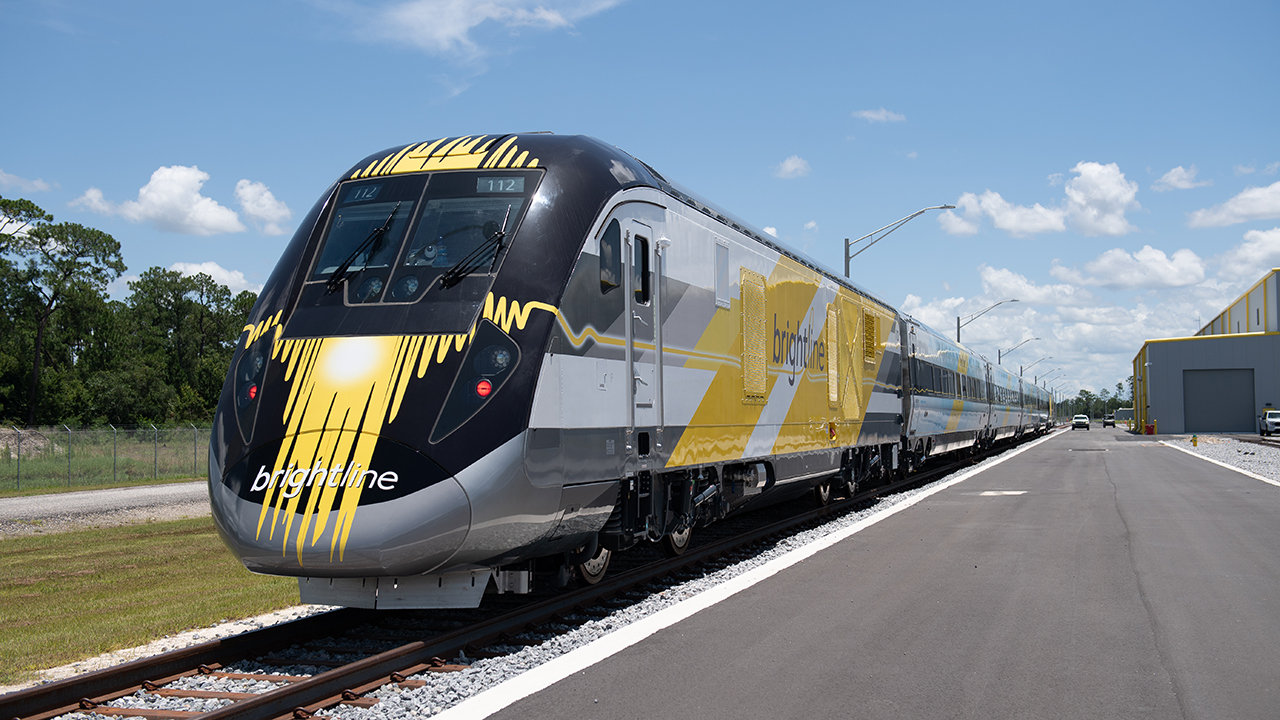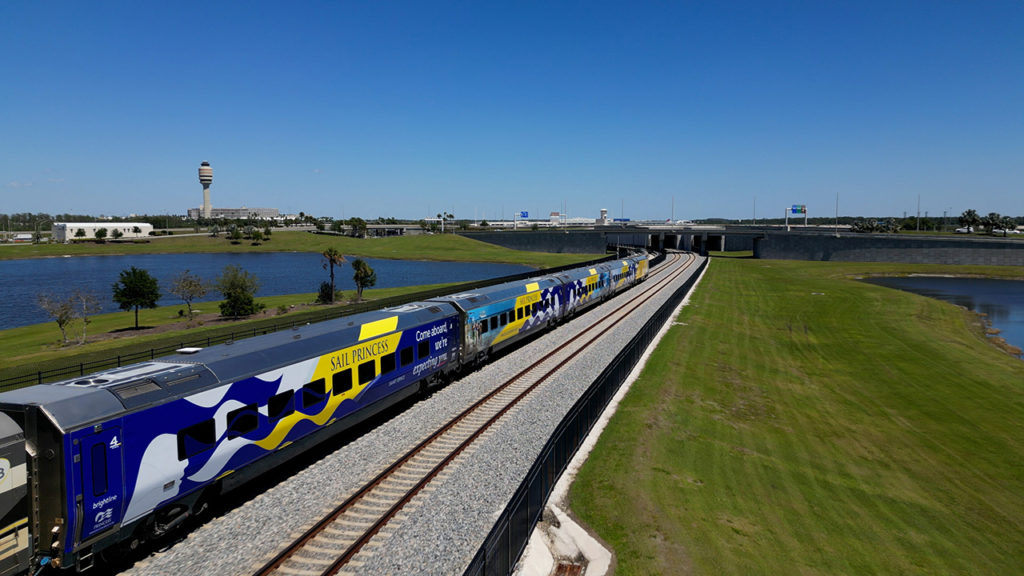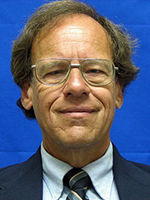
Brightline, End to End
Written by David Peter Alan, Contributing Editor
David C. Lester photo.
On Sept. 22, 2023, Brightline ran its first train from the railroad’s new station at Orlando International Airport (coded MCO) to its Miami Central Station. That run was accompanied by a capacity crowd on the airport station’s platform and a great deal of fanfare, as the nation’s only private-sector passenger railroad running scheduled service every day extended its operation from West Palm Beach beyond the South Florida region, including on new purpose-built higher-speed right-of-way.
That was slightly more than six months ago, and it was time to ride again, now that the operation has become routine. My ride on April 4, marked my first time on Brightline north of West Palm Beach, and it was exciting to anticipate riding on some new railroad built exclusively for passenger service, along with a line that had not hosted any scheduled passenger trains between 1968 and 2023.
To get the experience that a seasoned rail traveler would have, I traveled to Orlando by rail, on Amtrak Train 91, the Silver Star, mainly because of its early arrival at Orlando. It arrived shortly after 11:00 AM, and it took about 10 minutes to walk to a bus stop on Orange Avenue, a main north-south street. The local LYNX bus to the airport, on the #11 route, arrived shortly before 11:30, and the run ended at the airport bus stop at 12:02. It would take an additional 17 minutes to reach the Brightline station.
Navigating the Airport, With Difficulty
There was no sign anywhere near the bus stop that indicated the location of the Brightline station. I got some directions from an airport employee: Take the escalator up two levels and walk through the atrium toward Terminal C. The bus stop was on the Terminal A side, and Terminal B was on the other side of the atrium. Terminal C was further away, but signs close to Terminal B indicated “Train Station” with an arrow. It led to the Terminal Link, a monorail that goes to Terminal C and its associated parking lots. The monorail ride took less than five minutes, and there were signs that led to Brightline’s station.
Brightline calls the entrance to that station “the wicket.” It was essentially an empty room with customer service agents stationed at house left, ticket vending machines (no cash allowed) at house right, and fare gates that require a ticket swipe in the middle, along with airport-style metal detectors and security guards operating them. Katie Mitzner, Brightline’s Public Affairs Director, came out to give me a tour of the station. During that time, she mentionedthat the signs directing passengers to Brightline originally referred to Brightline’s station as the “Intermodal Terminal Facility” but they now say “Train Station.”
The Station and its Features
Terminal C and the Brightline station are the airport’s south terminals. All Brightline’s stations in South Florida have a look and feel reminiscent of airports, so it came as no surprise that a station located within an airport would sport a similar look and feel. There were two boarding lounges: a “Smart Lounge” for coach passengers (Brightline calls its coach class “Smart Class”) and a “Premium Lounge” that has snacks and beverages for passengers who pay the higher fare. There is also the “Mary Mary” bar, a feature at all Brightline stations. The name came from Henry M. Flagler, who founded the Florida East Coast Railway (FEC), on which Brightline runs. Two of his three wives were named Mary. There was also a retailing area that featured souvenirs, both of Orlando and of Brightline.
There were also some features unique to the Orlando facility. There was a display of pictures of Flagler from the period of his FEC career. Some of the track lighting consists of the lights used to illuminate motion picture sets for shooting, a tribute to the film industry, which once operated in the Sunshine State. Another is a Solari board over the bar, and the letters flip to different positions to display different messages. Boards like that once announced departures from many stations, particularly in the Northeast, but they have been replaced by illuminated departure boards at those locations.
A significant operational difference from the other Brightline stations is that the Orlando facility has two side platforms, rather than the island platform the other stations have. The layout includes room for a third track, which would be added as part of the railroad’s plan to extend service to Tampa in the future. The platforms are 1,000 feet long, far longer than needed to accommodate Brightline’s four-car consists with a locomotive at each end, but capable of accommodating trains up to 10 cars long. Brightline has more cars on order, though. Mitzner said that 30 cars have been ordered, and Brightline is expecting 10 to be delivered this year. She also told Railway Age that Brightline had built non-railroad infrastructure at the airport to facilitate road access and other functions, as well.
Mitzner also described four zones of Brightline’s own construction to extend the railroad to the airport and upgrade the existing FEC main. First there is Brightline’s maintenance facility, which they call “Basecamp.” Second, there is the non-revenue track in the airport zone. Third, there is the new railroad between the airport and Cocoa, where Brightline turns onto the FEC, heading toward Miami. The new railroad is capable of a top speed of 125 mph, is used exclusively by Brightline for its passenger trains, and was purpose-built for the current service. It runs along the Beachline Expressway, also known as State Route 528, running eastward from the airport toward the FEC main. Finally, there is the FEC north of West Palm Beach, which was upgraded for 95-mph running. That work included upgrading the bridges along the line.
Taking the Ride
Trains run hourly between Miami Central Station and Orlando Airport for most of the service day. The current schedule calls for 16 daily trains in each direction. The next one was due to leave at 1:50, and I rode in Premium Class going southbound. The cars are Siemens “Venture” cars, similar to the ones now running in corridor service on Amtrak and VIA Rail. The train set assigned to that run was the “Bright Green” consist. The original paint schemes for Brightline’s trains featured yellow and black, with a stripe of a bright color toward the middle of the car. The look is distinctive and the original green, blue, red, yellow, orange and pink are definitely bright, a festive touch with some color variety for the fleet.
There is one “Premium” car in each consist, while the other three cars are coaches, which Brightline calls “Smart” Class. Premium Class cars have 2-1 seating, and the seats are 21 inches wide. The other difference between classes is that Premium class includes food and drinks. The offerings included a can of “Pernicious IPA” from Wicked Weed Brewing in North Carolina, a sub-style sandwich on ciabatta bread, a fruit cup, snacks like wafers and breakfast bars, and coffee or soft drinks ($8, $14, $6, $4, and $4, respectively for passengers in the “Smart” coaches), distributed or sold from a cart in the aisle.
The railroad was smooth, and the trains rode well, both on the new railroad and on the segment that uses the FEC main. The crew was friendly and appeared to do all they could to serve their passengers.
As for scenery, that is not Florida’s strong suit anywhere in the state, except for the beautiful ocean views that are not located near any railroads that currently operate in the Sunshine State. Flagler’s goal for the FEC was to bring it through the chain of islands knows as the Florida Keys, all the way to Key West. He achieved it, and the part of the railroad between there and Miami was known as the “railroad that went to sea.” It opened for service in 1912, but lasted only until 1935, when a hurricane caused significant damage. It was never rebuilt. So, there is not much to see through the windows on Brightline trains, but neither is there much to see in Florida on Amtrak or the local railroads, SunRail and Tri-Rail. If there was one scene to behold during the ride, it was watching the vehicles on the highway appearing to be left behind by our train, which was moving at approximately double the speed of those vehicles.
Ridership was light leaving Orlando Airport: 18 in the Premium car and 95 in the three “Smart class” cars. South of West Palm Beach, it grew to 44 in Premium and 152 in the other three cars. Apparently, some South Florida residents are paying a premium for a fast ride within the region on a new train. The fares are considerably higher than on Tri-Rail, which runs on the historic Seaboard Railroad, several miles inland from the FEC line, where Brightline runs. Both run approximately hourly during most of the service day, and the service days on both begin early in the morning and end by mid-evening.
The line went through some of the towns where the old FEC passenger trains stopped, but it was not always easy to recognize the centers of town. One that could easily be seen is Stuart, where Brightline plans to establish an infill station. One reason why Stuart might have been selected over Fort Pierce is that the railroad runs closer to the center of town than to the center of Fort Pierce. There are also plans to establish an infill station at Cocoa, where Brightline leaves the FEC and go onto the new railroad.
A Look at Miami
Our train arrived at Miami Central station on schedule at 5:15 PM. It was my first visit to the facility since the early days of service there, before the COVID-19 virus struck. Michael Hicks, a Strategic Communications Consultant at Brightline, met my train and showed me how the station had changed. There were minor changes, like a display of historic photos of Overtown, a longstanding Black neighborhood near the new station. A more-significant change is the addition of a platform for Tri-Rail, the regional passenger-rail service that runs inland, north to Mangonia Park, beyond West Palm Beach.
Brightline and Tri-Rail stations are adjacent in the same facility, but they operate separately. Brightline has airport-style security found at other Brightline stations, while Tri-Rail has a separate entrance with benches on the platform where riders wait for their trains. It does not appear likely that Miami Central will become a transfer point between the services. At this writing, Tri-Rail is running a shuttle operation between Miami Central and Metrorail Transfer, a station about 20 minutes north, where connections are available to Tri-Rail trains between Miami Airport and points north, as well as to Metrorail, an elevated Metropolitan-style heavy rail line. It seems unlikely that many riders would ride the shuttle to get to Metrorail, though, because Miami Central station is located a few blocks from Metrorail downtown, and is served by the Metromover, a local monorail. Orlando riders transferring to Tri-Rail would probably do that at West Palm Beach, where the two stations are a few blocks apart, rather than taking the time required for an extra trip between Miami and their destination.
With a few hours to explore downtown Miami, I took Hicks’s advice and saw the Bayfront Marketplace on Biscayne Boulevard, a few blocks from the station. It is more of a food and entertainment complex, but it has vendors. It was crowded, and many visitors were taking notice of the boats on Biscayne Bay.
After that, there was time to walk around downtown Miami, which has a small historic area, nestled among new high-rise construction. There are only a few historic office buildings left, along with a few churches, but there was enough time to see monuments to Miami’s past, like the Ingraham Building (1927), built by the Flagler organization and named after one of Flagler’s business colleagues.
The Trip Back North
At Katie Mitzner’s suggestion, I took the last Brightline train back to Orlando Airport. It left at 9:45 PM, and ran with what was originally called the Bright Blue consist. There was no way to know that from looking at the train, since it was entirely wrapped with advertising for Orlando Health, a major hospital. It was difficult to see through the windows, which had been covered, but it was dark at that time.
The last departure at 9:45 made an early curfew, especially considered the ridership on the train. There were 161 riders in the “Smart” coaches and 18 in Premium when the train left Miami. Between Fort Lauderdale and West Palm Beach, the counts dropped to 86 and 14. There were only 54 and 5 when the train arrived at Orlando Airport at 1:15 AM. Those numbers only provide anecdotal evidence but, if they are any indication of regular ridership, it appears that Brightline has established a luxury-style local ridership in the territory where Tri-Rail runs west of Brightline’s route.
I rode north in “Smart” Class, so I could experience both classes of service. There were two differences between them. The “Smart” coaches had 2-2 seating, with seats that were 19 inches wide. Otherwise, the seats were similar to those in the “Premium” car. They had thin padding, without the feeling of cushions on the seat or in the back. The bottoms of the seats slid forward about two inches, but the seats did not otherwise recline. There were no footrests, and half of the seats faced backwards, when the train ran in either direction. The equipment, Siemens “Venture” cars, has become standard in corridors in North America. Brightline ordered them and placed them into service first, but they now run on corridors on VIA Rail in Canada and are proliferating throughout Amtrak’s corridors.
Orlando and Home
With its 59 riders including me, the train arrived shortly before the advertised time of 1:15 AM. The station was closing, but the station manager said that some riders sat in the airport lobby outside the Brightline entrance for the station to open. That happened at 4:00, for riders on the first departure at 4:50 to get ready to catch their train. By permission from Brightline, I had a cup of coffee at the Mary Mary Bar and waited for the sun to come up.
Leaving the Brightline station, it took only 11 minutes to make my way to the bus stop, where I caught a local bus for the 40-minute ride to downtown Orlando. I spent the rest of the morning walking around downtown and, as with Miami, getting a view of the few historic buildings left. One of the most-interesting is the once-abandoned Church Street Station, which is now a stop on SunRail. It was a long ride on Amtrak Train 98, starting with a delay of almost two hours, due to the need to recrew a freight train at Davenport, south of Kissimmee. The train lost another hour on its way to New York. What else is new?
Closing Impressions
It’s always exciting to ride a new passenger train service, and Brightline is somewhat different, since it is in the private sector. We have reported on plans to open stations at Stuart and Cocoa, which seem like two steps in the right direction. Still, there are several other towns on the way north from West Palm Beach, which could also accommodate more riders. Brightline is expecting many of them, and time will tell how many show up to ride. There are plans to go to Tampa, but that will have to wait for the proposed Sunshine Corridor, which is still several years off. Allowing an Amtrak train to run to Jacksonville or running a connecting train there for points north might be another ridership source, too.
Before that happens, it looks like Brightline West between the Los Angeles area and Las Vegas might start running. We’re looking forward to riding it and reporting to you about the experience.
New “Rail & Sail” Program

Princess Cruises and Brightline have joined forces to introduce the Rail & Sail program, offering guests “swift and hassle-free access to Princess cruise ships” departing from Florida homeports Fort Lauderdale and Orlando (Port Canaveral). Princes customers “enjoy a seamless journey in luxurious comfort, arriving at their preferred homeport in significantly less time than traditional travel methods,” the companies said.
Also available is a “value-added luggage express service” offering the convenience of bags checked at a Brightline station and delivered to their stateroom upon arrival at the ship. Princess added it will also provide customers with complimentary motorcoach service between Brightline’s Orlando and Fort Lauderdale stations and their embarkation terminal.
To help market the new service, Brightline wrapped four cars on one trainset with Princess’ “Love Boat” branding, complete with its signature seawitch logo and depictions of popular ports of call. Princess branding will also be featured at Brightline’s five terminals throughout Florida.
The Rail & Sail program includes discounted cruise packages through early May, provided the cruise is booked through Brightline’s website.

David Peter Alan is one of North America’s most experienced transit users and advocates, having ridden every rail transit line in the U.S., and most Canadian systems. He has also ridden the entire Amtrak and VIA Rail network. His advocacy on the national scene focuses on the Rail Users’ Network (RUN), where he has been a Board member since 2005. Locally in New Jersey, he served as Chair of the Lackawanna Coalition for 21 years and remains a member. He is also Chair of NJ Transit’s Senior Citizens and Disabled Residents Transportation Advisory Committee (SCDRTAC). When not writing or traveling, he practices law in the fields of Intellectual Property (Patents, Trademarks and Copyright) and business law. Opinions expressed here are his own.



